Submitted:
22 February 2024
Posted:
23 February 2024
You are already at the latest version
Abstract
Keywords:
1. Introduction
1.1. Research Gap and Our Novel Contribution
2. Materials and Methods
2.1. Study area description
- •
- Bangkok; an urban area located at latitude 38’N and longitude 54’E. This area is flat and low-lying, with altitudes ranging from 1.50 m to 2.0 m. It occupies and consists of 50 districts with a registered population of 5,527,994, known as the most highly inhabited city in Thailand. Built-up area covers 67.36% while agricultural land shows 0.16% of total area. The annual mean temperature ranges from to , the average maximum temperature in April is to , and the average minimum in January is to . The annual average rainfall is 1,700 mm, the average relative humidity is 73%, and the average wind speed is 12 km/h.
- •
- Pathum Thani; a peri-urban area is located at latitude 01’N and longitude 32’E with an average altitude of 2.30 m. It occupies and consists of 7 districts with a registered population of 1,190,060. The annual mean temperature ranges from to , the average maximum temperature in April is to , and the average minimum in December is to . The annual average rainfall is 1,200-1,400 mm, the average relative humidity is 80%, and the average wind speed is 16-21 km/h. This setting is characterized by 29.79% of the land serving as city outskirts to accommodate dense dwellings, industrial estates, and no forest areas.
- •
- Saraburi; a rural area located at latitude 31’N and longitude 54’E, with altitudes ranging from 2.0 m to 10.0 m. This area occupies , and 643,963 registered residents live in 13 districts of this countryside. The annual mean temperature is , with the average maximum temperature in April being and the average minimum temperature in January being . The annual average rainfall is 1,185 mm, the average relative humidity is 79.9%, and the average wind speed is 1.49 km/h. Approximately 78% of this province is occupied by agricultural land and forest areas.
2.2. Data Sources
2.2.1. Ground-observed air temperature data
2.2.2. Satellite-observed land surface temperature data
2.2.3. Elevation and land use
2.3. Methods
2.3.1. Data gap-filling
- 2.3.1.1 Spatiotemporal ground-observed air temperature gap-filling
- 2.3.1.2 Spatiotemporal satellite-based land surface temperature gap-filling
- 2.3.1.3 Model performance and accuracy assessment of predicting land surface temperature
2.3.2. Heatwave definition and its metric detection
2.3.3. Ground-observed air temperature and satellite-based land surface temperature heatwave metric trend analysis
2.3.4. Spatial homogeneity in correlation analysis
3. Results
3.1. Predicting land surface temperature to fill in missing satellite data and variable importance
3.2. Heatwave detection and measurement
3.2.1. Ground-observed air temperature heatwave
3.2.2. Satellite-based land surface temperature heatwave
3.3. Trend analysis for temporal heatwave metric detection
3.3.1. Ground-observed air temperature trend
3.3.2. Satellite-based land surface temperature trend
3.4. Spatial homogeneity in correlation analysis
4. Discussion
4.1. Accuracy and validation of land surface temperature predictive modeling
4.2. Heatwave detection and its characteristic measurement
4.2.1. Ground-observed air temperature assessment
4.2.2. Satellite-based land surface temperature assessment
4.3. Temporal heatwave metric trend analysis
4.3.1. Ground-observed air temperature heatwave trend
4.3.2. Satellite-based land surface temperature trend
4.4. Spatial homogeneity in correlation analysis between detected heatwave indices from ground-observed air temperature and satellite-based land surface temperature
4.5. Summary of comparing research findings with related existing works
4.6. Limitations and Future Research
- Scope of the Study: The primary objective of this research was to analyze and characterize heatwave patterns in different socio-economic regions of Thailand. Delving into comprehensive solutions would require an expanded scope, considering various aspects such as public health, urban planning, and community resilience, which fall beyond the intended focus of this study.
- Interdisciplinary Nature of Solutions: Addressing the impacts of heatwaves involves an interdisciplinary approach that spans fields such as climatology, public health, urban planning, and community engagement. While our study contributes valuable insights into the patterns and characteristics of heatwaves, developing holistic solutions requires collaborative efforts from experts in these diverse fields.
- Data Limitations: The availability of comprehensive and reliable data is crucial for proposing effective solutions. Incomplete observation records and the limited temporal synchronization between and MODIS-LST data pose challenges in formulating robust strategies.
5. Concluding Remarks and Possible Future Works
Author Contributions
Funding
Acknowledgments
Data Availability Statement
Conflicts of Interest
References
- Manyuchi, A.E.; Vogel, C.; Wright, C.Y.; Erasmus, B. The self-reported human health effects associated with heat exposure in Agincourt sub-district of South Africa. Humanities and Social Sciences Communications 2022, 9. [Google Scholar] [CrossRef] [PubMed]
- Sheridan, S.C.; Allen, M.J. Changes in the Frequency and Intensity of Extreme Temperature Events and Human Health Concerns. Current Climate Change Reports 2015, 1, 155–162. [Google Scholar] [CrossRef]
- Xu, H.; Xiao, J.; Zhang, Z. Heatwave effects on gross primary production of northern mid-latitude ecosystems. Environmental Research Letters 2020, 15. [Google Scholar] [CrossRef]
- García-León, D.; Casanueva, A.; Standardi, G.; Burgstall, A.; Flouris, A.D.; Nybo, L. Current and projected regional economic impacts of heatwaves in Europe. Nature Communications 2021, 12, 1–10. [Google Scholar] [CrossRef] [PubMed]
- Vitali, A.; Felici, A.; Esposito, S.; Bernabucci, U.; Bertocchi, L.; Maresca, C.; Nardone, A.; Lacetera, N. The effect of heat waves on dairy cow mortality. Journal of Dairy Science 2015, 98, 4572–4579. [Google Scholar] [CrossRef] [PubMed]
- Ruffault, J.; Curt, T.; Moron, V.; Trigo, R.M.; Mouillot, F.; Koutsias, N.; Pimont, F.; Martin-StPaul, N.; Barbero, R.; Dupuy, J.L.; Russo, A.; Belhadj-Khedher, C. Increased likelihood of heat-induced large wildfires in the Mediterranean Basin. Scientific Reports 2020, 10. [Google Scholar] [CrossRef] [PubMed]
- Anderson, M.C.; Zolin, C.A.; Sentelhas, P.C.; Hain, C.R.; Semmens, K.; Tugrul Yilmaz, M.; Gao, F.; Otkin, J.A.; Tetrault, R. The Evaporative Stress Index as an indicator of agricultural drought in Brazil: An assessment based on crop yield impacts. Remote Sensing of Environment 2016, 174, 82–99. [Google Scholar] [CrossRef]
- Stone, B.; Mallen, E.; Rajput, M.; Gronlund, C.J.; Broadbent, A.M.; Krayenhoff, E.S.; Augenbroe, G.; O’Neill, M.S.; Georgescu, M. Compound Climate and Infrastructure Events: How Electrical Grid Failure Alters Heat Wave Risk. Environmental Science and Technology 2021, 55, 6957–6964. [Google Scholar] [CrossRef] [PubMed]
- Hasan, F.; Marsia, S.; Patel, K.; Agrawal, P.; Razzak, J.A. Effective community-based interventions for the prevention and management of heat-related illnesses: A scoping review, 2021. [CrossRef]
- Taalas, P.; Guterres, A.; WMO. WMO statement on the state of the global climate in 2019; 2020; Volume 1248. [Google Scholar]
- World Meteorological Organization. State of the Global Climate 2022. Technical report, 2023.
- Jones, D.S. Killer Heat Waves Are Coming; Technical report; Harvard University: Cambridge, MA, 2023. [Google Scholar]
- Sera, F.; Armstrong, B.; Tobias, A.; Vicedo-Cabrera, A.M.; Åström, C.; Bell, M.L.; Chen, B.Y.; De Sousa Zanotti Stagliorio Coelho, M.; Correa, P.M.; Cruz, J.C.; Dang, T.N.; Hurtado-Diaz, M.; Do Van, D.; Forsberg, B.; Guo, Y.L.; Guo, Y.; Hashizume, M.; Honda, Y.; Iñiguez, C.; Jaakkola, J.J.; Kan, H.; Kim, H.; Lavigne, E.; Michelozzi, P.; Ortega, N.V.; Osorio, S.; Pascal, M.; Ragettli, M.S.; Ryti, N.R.; Saldiva, P.H.N.; Schwartz, J.; Scortichini, M.; Seposo, X.; Tong, S.; Zanobetti, A.; Gasparrini, A. How urban characteristics affect vulnerability to heat and cold: A multi-country analysis. International Journal of Epidemiology 2019, 48, 1101–1112. [Google Scholar] [CrossRef] [PubMed]
- Mazdiyasni, O.; Sadegh, M.; Chiang, F.; AghaKouchak, A. Heat wave Intensity Duration Frequency Curve: A Multivariate Approach for Hazard and Attribution Analysis. Scientific Reports 2019, 9. [Google Scholar] [CrossRef]
- Perkins-Kirkpatrick, S.E.; Lewis, S.C. Increasing trends in regional heatwaves. Nature Communications 2020, 11. [Google Scholar] [CrossRef] [PubMed]
- Koutroumanou-Kontosi, K.; Cartalis, C.; Philippopoulos, K.; Agathangelidis, I.; Polydoros, A. A Methodology for Bridging the Gap between Regional- and City-Scale Climate Simulations for the Urban Thermal Environment. Climate 2022, 10. [Google Scholar] [CrossRef]
- Fischer, E.M.; Sippel, S.; Knutti, R. Increasing probability of record-shattering climate extremes. Nature Climate Change 2021, 11, 689–695. [Google Scholar] [CrossRef]
- Ballester, J.; Quijal-Zamorano, M.; Méndez Turrubiates, R.F.; Pegenaute, F.; Herrmann, F.R.; Robine, J.M.; Basagaña, X.; Tonne, C.; Antó, J.M.; Achebak, H. Heat-related mortality in Europe during the summer of 2022. Nature Medicine 2023, 29, 1857–1866. [Google Scholar] [CrossRef] [PubMed]
- Lange, I.D.; Schoenig, E.; Khokiattiwong, S. Thailand. In World Seas: An Environmental Evaluation Volume II: The Indian Ocean to the Pacific; Elsevier, 2018; pp. 491–513. [CrossRef]
- La Yaung, K.; Chidthaisong, A.; Limsakul, A.; Varnakovida, P.; Nguyen, C.T. Land use land cover changes and their effects on surface air temperature in Myanmar and Thailand. Sustainability (Switzerland) 2021, 13. [Google Scholar] [CrossRef]
- Limjirakan, S.; Limsakul, A. Observed trends in surface air temperatures and their extremes in Thailand from 1970 to 2009. Journal of the Meteorological Society of Japan 2012, 90, 647–662. [Google Scholar] [CrossRef]
- Kachenchart, B.; Kamlangkla, C.; Puttanapong, N.; Limsakul, A. Urbanization effects on surface air temperature trends in Thailand during 1970-2019. Environmental Engineering Research 2021, 26. [Google Scholar] [CrossRef]
- Huang, C.; Cheng, J.; Phung, D.; Tawatsupa, B.; Hu, W.; Xu, Z. Mortality burden attributable to heatwaves in Thailand: A systematic assessment incorporating evidence-based lag structure. Environment International 2018, 121, 41–50. [Google Scholar] [CrossRef] [PubMed]
- Gao, J.; Sun, Y.; Liu, Q.; Zhou, M.; Lu, Y.; Li, L. Impact of extreme high temperature on mortality and regional level definition of heat wave: A multi-city study in China. Science of the Total Environment 2015, 505, 535–544. [Google Scholar] [CrossRef]
- Baccini, M.; Kosatsky, T.; Analitis, A.; Anderson, H.R.; D’Ovidio, M.; Menne, B.; Michelozzi, P.; Biggeri, A.; Kirchmayer, U.; De’Donato, F.; D’Ovidio, M.; D’Ippoliti, D.; Marino, C.; McGregor, G.; Accetta, G.; Katsouyanni, K.; Kassomenos, P.; Sunyer, J.; Atkinson, R.; Medina, S.; Paldy, A.; Bisanti, L.; Cadum, G.; Kriz, B.; Hojs, A.; Clancy, L.; Goodman, P.; Forsberg, B.; Pekkanen, J.; Woityniak, B.; Jolliffe, I.; Jendritzky, G.; Blazejczyk, K.; Huth, R.; Cegnar, T.; Schindler, C.; Ballester, F.; Monceau, G.; Kalkstein, L.S. Impact of heat on mortality in 15 European cities: Attributable deaths under different weather scenarios. Journal of Epidemiology and Community Health 2011, 65, 64–70. [Google Scholar] [CrossRef]
- Brooke Anderson, G.; Bell, M.L. Heat waves in the United States: Mortality risk during heat waves and effect modification by heat wave characteristics in 43 U.S. communities. Environmental Health Perspectives 2011, 119, 210–218. [Google Scholar] [CrossRef] [PubMed]
- Peng, R.D.; Bobb, J.F.; Tebaldi, C.; McDaniel, L.; Bell, M.L.; Dominici, F. Toward a quantitative estimate of future heat wave mortality under global climate change. Environmental Health Perspectives 2011, 119, 701–706. [Google Scholar] [CrossRef] [PubMed]
- Ishigami, A.; Hajat, S.; Kovats, R.S.; Bisanti, L.; Rognoni, M.; Russo, A.; Paldy, A. An ecological time-series study of heat-related mortality in three European cities. Environmental Health: A Global Access Science Source 2008, 7. [Google Scholar] [CrossRef] [PubMed]
- Tawatsupa, B.; Dear, K.; Kjellstrom, T.; Sleigh, A.; Samakkeekarom, R. Association between Temperature and Mortality among the Working Age Population in Thailand from 1999 to 2008. Journal of Population and Social Studies 2014, 22, 192–201. [Google Scholar] [CrossRef]
- Chen, K.; Boomsma, J.; Holmes, H.A. A multiscale analysis of heatwaves and urban heat islands in the western US during the summer of 2021. Scientific Reports 2023, 13, 9570. [Google Scholar] [CrossRef]
- Sheridan, S.C.; Allen, M.J. Temporal trends in human vulnerability to excessive heat. Environmental Research Letters 2018, 13. [Google Scholar] [CrossRef]
- Turner, B.L. LOCAL FACES, GLOBAL FLOWS: THE ROLE OF LAND USE AND LAND COVER IN GLOBAL ENVIRONMENTAL CHANGE. Technical report, 1994.
- Yee, K.M.; Ahn, H.; Shin, D.; Choi, C. Relationship assessment among land use and land cover and land surface temperature over downtown and suburban areas in Yangon City, Myanmar. Korean Journal of Remote Sensing 2016, 32, 353–364. [Google Scholar] [CrossRef]
- Wilhelmi, O.V.; Hayden, M.H. Connecting people and place: a new framework for reducing urban vulnerability to extreme heat. Environmental Research Letters 2010, 5, 014021. [Google Scholar] [CrossRef]
- Igun, E.; Xu, X.; Hu, Y.; Jia, G. Strong heatwaves with widespread urban-related hotspots over Africa in 2019. Atmospheric and Oceanic Science Letters 2022, 15, 100195. [Google Scholar] [CrossRef]
- Meehl, G.A.; Tebaldi, C. More intense, more frequent, and longer lasting heat waves in the 21st century. Science 2004, 305, 994–997. [Google Scholar] [CrossRef]
- Strathearn, M.; Osborne, N.J.; Selvey, L.A. Impact of low-intensity heat events on mortality and morbidity in regions with hot, humid summers: a scoping literature review, 2022. [CrossRef]
- Horton, R.M.; Mankin, J.S.; Lesk, C.; Coffel, E.; Raymond, C. A Review of Recent Advances in Research on Extreme Heat Events, 2016. [CrossRef]
- Abadie, L.M.; Chiabai, A.; Neumann, M.B. Stochastic diffusion models to describe the evolution of annual heatwave statistics: A three-factor model with risk calculations. Science of the Total Environment 2019, 646, 670–684. [Google Scholar] [CrossRef] [PubMed]
- Adnan, M.S.G.; Dewan, A.; Botje, D.; Shahid, S.; Hassan, Q.K. Vulnerability of Australia to heatwaves: A systematic review on influencing factors, impacts, and mitigation options, 2022. [CrossRef]
- Perkins, S.E.; Alexander, L.V. On the measurement of heat waves. Journal of Climate 2013, 26, 4500–4517. [Google Scholar] [CrossRef]
- Kirtsaeng, S.; Kirtsaeng, P. Analysis and simulation of heat index for developing a heat alert system over Thailand. ACDT 2015 - Proceedings: The 1st Asian Conference on Defence Technology. Institute of Electrical and Electronics Engineers Inc., 2015, pp. 63–68. [CrossRef]
- Ouzeau, G.; Soubeyroux, J.M.; Schneider, M.; Vautard, R.; Planton, S. Heat waves analysis over France in present and future climate: Application of a new method on the EURO-CORDEX ensemble. Climate Services 2016, 4, 1–12. [Google Scholar] [CrossRef]
- Zhang, Y.; Wang, Y.; Ding, N. Spatial Effects of Landscape Patterns of Urban Patches with Different Vegetation Fractions on Urban Thermal Environment. Remote Sensing 2022, 14, 5684. [Google Scholar] [CrossRef]
- Fröhlich, D.; Matzarakis, A. Calculating human thermal comfort and thermal stress in the PALM model system 6.0. Geoscientific Model Development 2020, 13, 3055–3065. [Google Scholar] [CrossRef]
- Schoen, C. A New Empirical Model of the Temperature-Humidity Index. Technical report, 2005.
- Perkins, S.E.; Alexander, L.V.; Nairn, J.R. Increasing frequency, intensity and duration of observed global heatwaves and warm spells. Geophysical Research Letters 2012, 39. [Google Scholar] [CrossRef]
- Rohini, P.; Rajeevan, M.; Srivastava, A.K. On the Variability and Increasing Trends of Heat Waves over India. Scientific Reports 2016, 6. [Google Scholar] [CrossRef] [PubMed]
- Hobday, A.J.; Alexander, L.V.; Perkins, S.E.; Smale, D.A.; Straub, S.C.; Oliver, E.C.; Benthuysen, J.A.; Burrows, M.T.; Donat, M.G.; Feng, M.; Holbrook, N.J.; Moore, P.J.; Scannell, H.A.; Sen Gupta, A.; Wernberg, T. A hierarchical approach to defining marine heatwaves. Progress in Oceanography 2016, 141, 227–238. [Google Scholar] [CrossRef]
- Agathangelidis, I.; Cartalis, C.; Polydoros, A.; Mavrakou, T.; Philippopoulos, K. Can Satellite-Based Thermal Anomalies Be Indicative of Heatwaves? An Investigation for MODIS Land Surface Temperatures in the Mediterranean Region. Remote Sensing 2022, 14, 3139. [Google Scholar] [CrossRef]
- Gasparrini, A.; Guo, Y.; Hashizume, M. Mortalité attribuable au froid et à la chaleur : Analyse multi-pays. Environnement, Risques et Sante 2015, 14, 464–465. [Google Scholar] [CrossRef]
- Buo, I.; Sagris, V.; Jaagus, J. Gap-Filling Satellite Land Surface Temperature over Heatwave Periods with Machine Learning. IEEE Geoscience and Remote Sensing Letters 2022, 19. [Google Scholar] [CrossRef]
- Mushore, T.D.; Mutanga, O.; Odindi, J.; Dube, T. Determining extreme heat vulnerability of Harare Metropolitan City using multispectral remote sensing and socio-economic data, 2018. [CrossRef]
- Malings, C.; Pozzi, M.; Klima, K.; Bergés, M.; Bou-Zeid, E.; Ramamurthy, P. Surface heat assessment for developed environments: Probabilistic urban temperature modeling. Computers, Environment and Urban Systems 2017, 66, 53–64. [Google Scholar] [CrossRef]
- Jin, M.; Dickinson, R.E. Land surface skin temperature climatology: Benefitting from the strengths of satellite observations. Environmental Research Letters 2010, 5. [Google Scholar] [CrossRef]
- Polydoros, A.; Mavrakou, T.; Cartalis, C. Quantifying the Trends in Land Surface Temperature and Surface Urban Heat Island Intensity in Mediterranean Cities in View of Smart Urbanization. Urban Science 2018, 2, 16. [Google Scholar] [CrossRef]
- Xiao, Y.; Zhao, W.; Ma, M.; He, K. Gap-free lst generation for modis/terra lst product using a random forest-based reconstruction method. Remote Sensing 2021, 13. [Google Scholar] [CrossRef]
- Duan, S.B.; Li, Z.L.; Leng, P. A framework for the retrieval of all-weather land surface temperature at a high spatial resolution from polar-orbiting thermal infrared and passive microwave data. Remote Sensing of Environment 2017, 195, 107–117. [Google Scholar] [CrossRef]
- Gerber, F.; de Jong, R.; Schaepman, M.E.; Schaepman-Strub, G.; Furrer, R. Predicting missing values in spatio-temporal remote sensing data. IEEE Transactions on Geoscience and Remote Sensing 2018, 56, 2841–2853. [Google Scholar] [CrossRef]
- Zeng, C.; Long, D.; Shen, H.; Wu, P.; Cui, Y.; Hong, Y. A two-step framework for reconstructing remotely sensed land surface temperatures contaminated by cloud. ISPRS Journal of Photogrammetry and Remote Sensing 2018, 141, 30–45. [Google Scholar] [CrossRef]
- Martins, J.P.; Trigo, I.F.; Ghilain, N.; Jimenez, C.; Göttsche, F.M.; Ermida, S.L.; Olesen, F.S.; Gellens-Meulenberghs, F.; Arboleda, A. An all-weather land surface temperature product based on MSG/SEVIRI observations. Remote Sensing 2019, 11, 3044. [Google Scholar] [CrossRef]
- Zhang, X.; Zhou, J.; Göttsche, F.M.; Zhan, W.; Liu, S.; Cao, R. A method based on temporal component decomposition for estimating 1-km all-weather land surface temperature by merging satellite thermal infrared and passive microwave observations. IEEE Transactions on Geoscience and Remote Sensing 2019, 57, 4670–4691. [Google Scholar] [CrossRef]
- Tan, W.; Wei, C.; Lu, Y.; Xue, D. Reconstruction of all-weather daytime and nighttime MODIS aqua-terra land surface temperature products using an XGBoost approach. Remote Sensing 2021, 13, 4723. [Google Scholar] [CrossRef]
- Mildrexler, D.J.; Zhao, M.; Running, S.W. A global comparison between station air temperatures and MODIS land surface temperatures reveals the cooling role of forests. Journal of Geophysical Research: Biogeosciences 2011, 116. [Google Scholar] [CrossRef]
- Liu, Y.; Peng, J.; Wang, Y. Diversification of land surface temperature change under urban landscape renewal: A case study in the main city of Shenzhen, China. Remote Sensing 2017, 9. [Google Scholar] [CrossRef]
- Peng, J.; Xie, P.; Liu, Y.; Ma, J. Urban thermal environment dynamics and associated landscape pattern factors: A case study in the Beijing metropolitan region. Remote Sensing of Environment 2016, 173, 145–155. [Google Scholar] [CrossRef]
- Chen, L.; Zhou, B.; Man, W.; Liu, M. Landsat-based monitoring of the heat effects of urbanization directions and types in hangzhou city from 2000 to 2020. Remote Sensing 2021, 13. [Google Scholar] [CrossRef]
- Keeratikasikorn, C.; Bonafoni, S. Satellite Images and Gaussian Parameterization for an Extensive Analysis of Urban Heat Islands in Thailand. Remote Sensing 2018, 10. [Google Scholar] [CrossRef]
- Keeratikasikorn, C.; Bonafoni, S. Urban Heat Island Analysis over the Land Use Zoning Plan of Bangkok by Means of Landsat 8 Imagery. Remote Sensing 2018, 10. [Google Scholar] [CrossRef]
- Pan, L.; Lu, L.; Fu, P.; Nitivattananon, V.; Guo, H.; Li, Q. Understanding spatiotemporal evolution of the surface urban heat island in the Bangkok metropolitan region from 2000 to 2020 using enhanced land surface temperature. Geomatics, Natural Hazards and Risk 2023, 14. [Google Scholar] [CrossRef]
- Chotchaiwong, P.; Wijitkosum, S. Relationship between land surface temperature and land use in Nakhon Ratchasima city, Thailand. Engineering Journal 2019, 23, 1–14. [Google Scholar] [CrossRef]
- Adulkongkaew, T.; Satapanajaru, T.; Charoenhirunyingyos, S.; Singhirunnusorn, W. Effect of land cover composition and building configuration on land surface temperature in an urban-sprawl city, case study in Bangkok Metropolitan Area, Thailand. Heliyon 2020, 6. [Google Scholar] [CrossRef]
- Hirsch, P. Re-thinking Frontiers in Southeast Asia. Technical Report 2, 2009.
- Goldstein, S.; Goldstein, A. THAILAND’S URBAN POPULATION RECONSIDERED. Technical Report 3, 1978.
- Zhu, W.; Lu, A.; Jia, S. Estimation of daily maximum and minimum air temperature using MODIS land surface temperature products. Remote Sensing of Environment 2013, 130, 62–73. [Google Scholar] [CrossRef]
- Niass, O.; Diongue, A.K.; Touré, A. Analysis of missing data in sero-epidemiological studies. African Journal of Applied Statistics 2015, 2, 29–37. [Google Scholar] [CrossRef]
- Mott, P.; Sammis, T.W.; Southward, G.M.; Asae, M. CLIMATE DATA ESTIMATION USING CLIMATE INFORMATION FROM SURROUNDING CLIMATE STATIONS. Technical report, 1994.
- Fulton, W.C.; Haynes, D.L. The Use of Regression Equations to Increase the Usefulness of Historical Temperature Data in On-line Pest Management 1 Downloaded from. Technical report, 2016.
- Kemp, W.; Burnell, D.; Everson, D.; Thomson, A. Estimating Missing Daily Maximum and Minimum Temperatures. American Meteorological Society 1983, 22, 1587–1593. [Google Scholar] [CrossRef]
- Ashraf, M.; Loftis, J.C.; Hubbard, K.G. AGRICULTURAL AND FOREST METEOROLOGY ELSEVIER Application of geostatistics to evaluate partial weather station networks. Technical report, 1997.
- Saleem, M.U.; Ahmed, S.R. Missing Data Imputations for Upper Air Temperature at 24 Standard Pressure Levels over Pakistan Collected from Aqua Satellite. Journal of Data Analysis and Information Processing 2016, 04, 132–146. [Google Scholar] [CrossRef]
- Apaydın, M.; Yumuş, M.; Değirmenci, A.; Karal, Ö. Evaluation of air temperature with machine learning regression methods using Seoul City meteorological data. Pamukkale University Journal of Engineering Sciences 2022, 28, 737–747. [Google Scholar] [CrossRef]
- Boomgard-Zagrodnik, J.P.; Brown, D.J. Machine learning imputation of missing Mesonet temperature observations. Computers and Electronics in Agriculture 2022, 192, 106580. [Google Scholar] [CrossRef]
- Jia, H.; Yang, D.; Deng, W.; Wei, Q.; Jiang, W. Predicting land surface temperature with geographically weighed regression and deep learning. Wiley Interdisciplinary Reviews: Data Mining and Knowledge Discovery 2021, 11. [Google Scholar] [CrossRef]
- Wu, P.; Yin, Z.; Yang, H.; Wu, Y.; Ma, X. Reconstructing geostationary satellite land surface temperature imagery based on a multiscale feature connected convolutional neural network. Remote Sensing 2019, 11, 300. [Google Scholar] [CrossRef]
- Yang, G.; Pu, R.; Huang, W.; Wang, J.; Zhao, C. A novel method to estimate subpixel temperature by fusing solar-reflective and thermal-infrared remote-sensing data with an artificial neural network. IEEE Transactions on Geoscience and Remote Sensing 2009, 48, 2170–2178. [Google Scholar]
- Zhang, X.; Zhang, Q.; Zhang, G.; Nie, Z.; Gui, Z.; Que, H. A novel hybrid data-driven model for daily land surface temperature forecasting using long short-term memory neural network based on ensemble empirical mode decomposition. International journal of environmental research and public health 2018, 15, 1032. [Google Scholar] [CrossRef]
- Wang, H.; Mao, K.; Yuan, Z.; Shi, J.; Cao, M.; Qin, Z.; Duan, S.; Tang, B. A method for land surface temperature retrieval based on model-data-knowledge-driven and deep learning. Remote Sensing of Environment 2021, 265. [Google Scholar] [CrossRef]
- Breiman, L. Random Forests. Technical report, 2001.
- Jacques-Dumas, V.; Ragone, F.; Borgnat, P.; Abry, P.; Bouchet, F. Deep Learning-Based Extreme Heatwave Forecast. Frontiers in Climate 2022, 4, 2103–09743. [Google Scholar] [CrossRef]
- Giamalaki, K.; Beaulieu, C.; Prochaska, J.X. Assessing Predictability of Marine Heatwaves With Random Forests. Geophysical Research Letters 2022, 49. [Google Scholar] [CrossRef]
- Tang, F.; Ishwaran, H. Random forest missing data algorithms. Statistical Analysis and Data Mining 2017, 10, 363–377. [Google Scholar] [CrossRef]
- Mital, U.; Dwivedi, D.; Brown, J.B.; Faybishenko, B.; Painter, S.L.; Steefel, C.I. Sequential Imputation of Missing Spatio-Temporal Precipitation Data Using Random Forests. Frontiers in Water 2020, 2. [Google Scholar] [CrossRef]
- Wang, Y.; Chen, X.; Gao, M.; Dong, J. The use of random forest to identify climate and human interference on vegetation coverage changes in southwest China. Ecological Indicators 2022, 144. [Google Scholar] [CrossRef]
- Pedregosa FABIANPEDREGOSA, F.; Michel, V.; Grisel OLIVIERGRISEL, O.; Blondel, M.; Prettenhofer, P.; Weiss, R.; Vanderplas, J.; Cournapeau, D.; Pedregosa, F.; Varoquaux, G.; Gramfort, A.; Thirion, B.; Grisel, O.; Dubourg, V.; Passos, A.; Brucher, M.; Perrot andÉdouardand, M.; andÉdouard Duchesnay.; Duchesnay EDOUARDDUCHESNAY, F. Scikit-learn: Machine Learning in Python Gaël Varoquaux Bertrand Thirion Vincent Dubourg Alexandre Passos PEDREGOSA, VAROQUAUX, GRAMFORT ET AL. Matthieu Perrot. Technical report, 2011.
- Yang, Y.Z.; Cai, W.H.; Yang, J. Evaluation of MODIS land surface temperature data to estimate near-surface air temperature in Northeast China. Remote Sensing 2017, 9. [Google Scholar] [CrossRef]
- Zheng, X.; Zhu, J.; Yan, Q. Monthly air temperatures over northern China estimated by integrating MODIS data with GIS techniques. Journal of Applied Meteorology and Climatology 2013, 52, 1987–2000. [Google Scholar] [CrossRef]
- Hirsch, A.L.; Ridder, N.N.; Perkins-Kirkpatrick, S.E.; Ukkola, A. CMIP6 MultiModel Evaluation of Present-Day Heatwave Attributes, 2021. [CrossRef]
- Dong, Z.; Wang, L.; Sun, Y.; Hu, T.; Limsakul, A.; Singhruck, P.; Pimonsree, S. Heatwaves in Southeast Asia and Their Changes in a Warmer World. Earth’s Future 2021, 9. [Google Scholar] [CrossRef]
- Damtew, A.; Teferi, E.; Ongoma, V.; Mumo, R.; Esayas, B. Spatiotemporal changes in mean and extreme climate: Farmers’ perception and its agricultural implications in Awash river basin, Ethiopia. Climate 2022, 10, 89. [Google Scholar] [CrossRef]
- Hussain, M.; Mahmud, I. pyMannKendall: a python package for non parametric Mann Kendall family of trend tests. Journal of Open Source Software 2019, 4, 1556. [Google Scholar] [CrossRef]
- Liang, L.; Yu, L.; Wang, Z. Identifying the dominant impact factors and their contributions to heatwave events over mainland China. Science of the Total Environment 2022, 848. [Google Scholar] [CrossRef] [PubMed]
- Sharifi, E.; Steinacker, R.; Saghafian, B. Multi time-scale evaluation of high-resolution satellite-based precipitation products over northeast of Austria. Atmospheric Research 2018, 206, 46–63. [Google Scholar] [CrossRef]
- Zhao, G.; Song, L.; Zhao, L.; Tao, S. Comparison of Different Machine Learning Methods to Reconstruct Daily Evapotranspiration Estimated by Thermal-Infrared Remote Sensing 2024. [CrossRef]
- Qin, Z.; Zhou, X.; Li, M.; Tong, Y.; Luo, H. Landslide Susceptibility Mapping Based on Resampling Method and FR-CNN: A Case Study of Changdu. Land 2023, 12, 1213. [Google Scholar] [CrossRef]
- Mathew, A.; Khandelwal, S.; Kaul, N. Analysis of diurnal surface temperature variations for the assessment of surface urban heat island effect over Indian cities. Energy and Buildings 2018, 159, 271–295. [Google Scholar] [CrossRef]
- Rengma, N.; Yadav, M. a Generic Machine Learning-Based Framework for Predictive Modeling of Land Surface Temperature. The International Archives of the Photogrammetry, Remote Sensing and Spatial Information Sciences 2023, 48, 95–102. [Google Scholar] [CrossRef]
- Xu, P.; Wang, L.; Huang, P.; Chen, W. Disentangling dynamical and thermodynamical contributions to the record-breaking heatwave over Central Europe in June 2019. Atmospheric Research 2021, 252, 105446. [Google Scholar] [CrossRef]
- Noi, P.T.; Degener, J.; Kappas, M. Comparison of multiple linear regression, cubist regression, and random forest algorithms to estimate daily air surface temperature from dynamic combinations of MODIS LST data. Remote sensing 2017, 9, 398. [Google Scholar] [CrossRef]
- Chung, J.; Lee, Y.; Jang, W.; Lee, S.; Kim, S. Correlation analysis between air temperature and MODIS land surface temperature and prediction of air temperature using tensorflow long short-term memory for the period of occurrence of cold and heat waves. Remote Sensing 2020, 12, 1–25. [Google Scholar] [CrossRef]
- Li, K.; Guan, K.; Jiang, C.; Wang, S.; Peng, B.; Cai, Y. Evaluation of four new land surface temperature (LST) products in the US corn belt: ECOSTRESS, GOES-R, landsat, and sentinel-3. IEEE Journal of Selected Topics in Applied Earth Observations and Remote Sensing 2021, 14, 9931–9945. [Google Scholar] [CrossRef]
- Galanaki, E.; Giannaros, C.; Kotroni, V.; Lagouvardos, K.; Papavasileiou, G. Spatio-Temporal Analysis of Heatwaves Characteristics in Greece from 1950 to 2020. Climate 2023, 11, 14–16. [Google Scholar] [CrossRef]
- Probst, P.; Boulesteix, A.L. To tune or not to tune the number of trees in random forest. Journal of Machine Learning Research 2018, 18, 1–18. [Google Scholar]
- US EPA, O. Climate Change and Heat Islands, 2014.
- Ramamurthy, P.; Bou-Zeid, E. Heatwaves and urban heat islands: a comparative analysis of multiple cities. Journal of Geophysical Research: Atmospheres 2017, 122, 168–178. [Google Scholar] [CrossRef]
- Kapwata, T.; Gebreslasie, M.T.; Wright, C.Y. An analysis of past and future heatwaves based on a heat-associated mortality threshold: towards a heat health warning system. Environmental health 2022, 21, 1–12. [Google Scholar] [CrossRef]
- Feng, J.; Wang, L.; Chen, W.; Fong, S.K.; Leong, K.C. Different impacts of two types of Pacific Ocean warming on Southeast Asian rainfall during boreal winter. Journal of Geophysical Research: Atmospheres 2010, 115. [Google Scholar] [CrossRef]
- Hamada, J.I.; Yamanaka, M.D.; Matsumoto, J.; Fukao, S.; Winarso, P.A.; Sribimawati, T. Spatial and temporal variations of the rainy season over Indonesia and their link to ENSO. Journal of the Meteorological Society of Japan 2002, 80, 285–310. [Google Scholar] [CrossRef]
- Juneng, L.; Tangang, F.T. Evolution of ENSO-related rainfall anomalies in Southeast Asia region and its relationship with atmosphere–ocean variations in Indo-Pacific sector. Climate Dynamics 2005, 25, 337–350. [Google Scholar] [CrossRef]
- McBride, J.L.; Haylock, M.R.; Nicholls, N. Relationships between the Maritime Continent heat source and the El Niño–Southern Oscillation phenomenon. Journal of climate 2003, 16, 2905–2914. [Google Scholar] [CrossRef]
- Caesar, J.; Alexander, L.; Trewin, B.; Tse-Ring, K.; Sorany, L.; Vuniyayawa, V.; Keosavang, N.; Shimana, A.; Htay, M.; Karmacharya, J.; others. Changes in temperature and precipitation extremes over the Indo-Pacific region from 1971 to 2005. International Journal of Climatology 2011, 31, 791–801. [Google Scholar] [CrossRef]
- Lin, L.; Wang, Z.; Xu, Y.; Zhang, X.; Zhang, H.; Dong, W. Additional Intensification of Seasonal Heat and Flooding Extreme Over China in a 2°C Warmer World Compared to 1.5°C. Earth’s Future 2018, 6, 968–978. [Google Scholar] [CrossRef]
- Thirumalai, K.; DInezio, P.N.; Okumura, Y.; Deser, C. Extreme temperatures in Southeast Asia caused by El Ninõ and worsened by global warming. Nature Communications 2017, 8. [Google Scholar] [CrossRef] [PubMed]
- Barriopedro, D.; García-Herrera, R.; Ordóñez, C.; Miralles, D.; Salcedo-Sanz, S. Heat waves: Physical understanding and scientific challenges. Reviews of Geophysics, 2022. [Google Scholar] [CrossRef]
- Arifwidodo, S.; Chandrasiri, O. Urban Heat Island and Household Energy Consumption in Bangkok, Thailand. Energy Procedia. Elsevier Ltd, 2015, Vol. 79, pp. 189–194. [CrossRef]
- Seneviratne, S. ; others. Weather and climate extreme events in a changing climate. In IPCC Sixth Assessment Report; 2022. [CrossRef]
- Robinson, A.; Lehmann, J.; Barriopedro, D.; Rahmstorf, S.; Coumou, D. Increasing heat and rainfall extremes now far outside the historical climate. npj Climate and Atmospheric Science 2021, 4, 45. [Google Scholar] [CrossRef]
- Wu, S.; Luo, M.; Zhao, R.; Li, J.; Sun, P.; Liu, Z.; Wang, X.; Wang, P.; Zhang, H. Local mechanisms for global daytime, nighttime, and compound heatwaves. npj Climate and Atmospheric Science 2023, 6, 36. [Google Scholar] [CrossRef]
- Marotzke, J.; Forster, P.M. Forcing, feedback and internal variability in global temperature trends. Nature 2015, 517, 565–570. [Google Scholar] [CrossRef]
- Schoetter, R.; Cattiaux, J.; Douville, H. Changes of western European heat wave characteristics projected by the CMIP5 ensemble. Climate Dynamics 2015, 45, 1601–1616. [Google Scholar] [CrossRef]
- Wei, C.; Chen, W.; Lu, Y.; Blaschke, T.; Peng, J.; Xue, D. Synergies between Urban Heat Island and Urban Heat Wave Effects in 9 Global Mega-Regions from 2003 to 2020. Remote Sensing 2021, 14, 70. [Google Scholar] [CrossRef]
- Zhao, H.; Zhang, H.; Miao, C.; Ye, X.; Min, M. Linking heat source–sink landscape patterns with analysis of urban heat islands: Study on the fast-growing Zhengzhou City in Central China. Remote Sensing 2018, 10, 1268. [Google Scholar] [CrossRef]
- Pereira Marghidan, C.; van Aalst, M.; Blanford, J.; Guigma, K.; Pinto, I.; Maure, G.; Marrufo, T. Heatwaves in Mozambique 1983–2016: Characteristics, trends and city-level summaries using high-resolution CHIRTS-daily. Weather and Climate Extremes 2023, 40, 100565. [Google Scholar] [CrossRef]
- Yadav, N.; Rajendra, K.; Awasthi, A.; Singh, C.; Bhushan, B. Systematic exploration of heat wave impact on mortality and urban heat island: A review from 2000 to 2022. Urban Climate 2023, 51, 101622. [Google Scholar] [CrossRef]
- Caesar, J.; Alexander, L.V.; Trewin, B.; Tse-ring, K.; Sorany, L.; Vuniyayawa, V.; Keosavang, N.; Shimana, A.; Htay, M.M.; Karmacharya, J.; Jayasinghearachchi, D.A.; Sakkamart, J.; Soares, E.; Hung, L.T.; Thuong, L.T.; Hue, C.T.; Dung, N.T.; Hung, P.V.; Cuong, H.D.; Cuong, N.M.; Sirabaha, S. Changes in temperature and precipitation extremes over the Indo-Pacific region from 1971 to 2005. International Journal of Climatology 2011, 31, 791–801. [Google Scholar] [CrossRef]
- Lin, L.; Chen, C.; Luo, M. Impacts of El Niño–Southern Oscillation on heat waves in the Indochina peninsula. Atmospheric Science Letters 2018, 19, e856. [Google Scholar] [CrossRef]
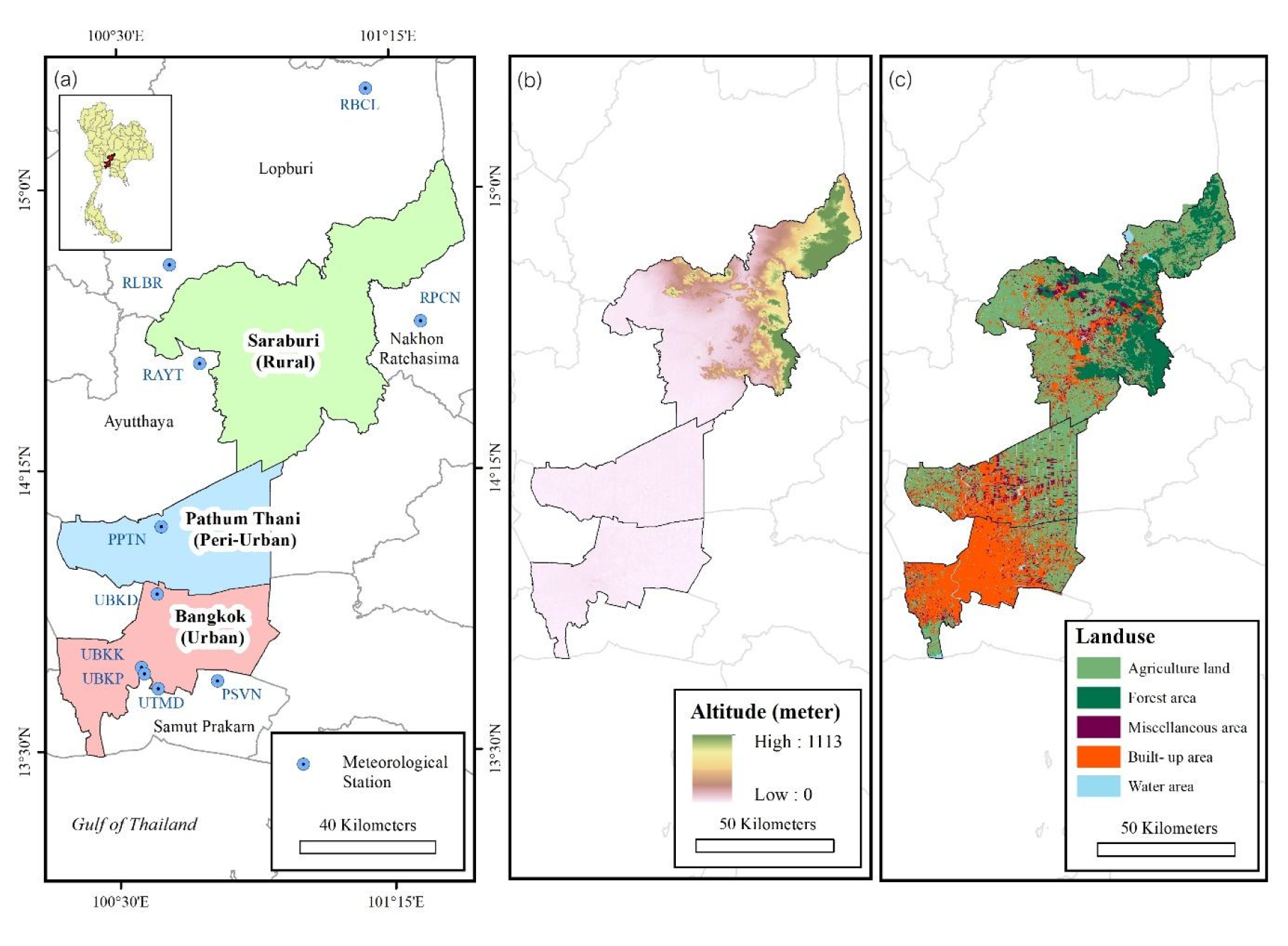
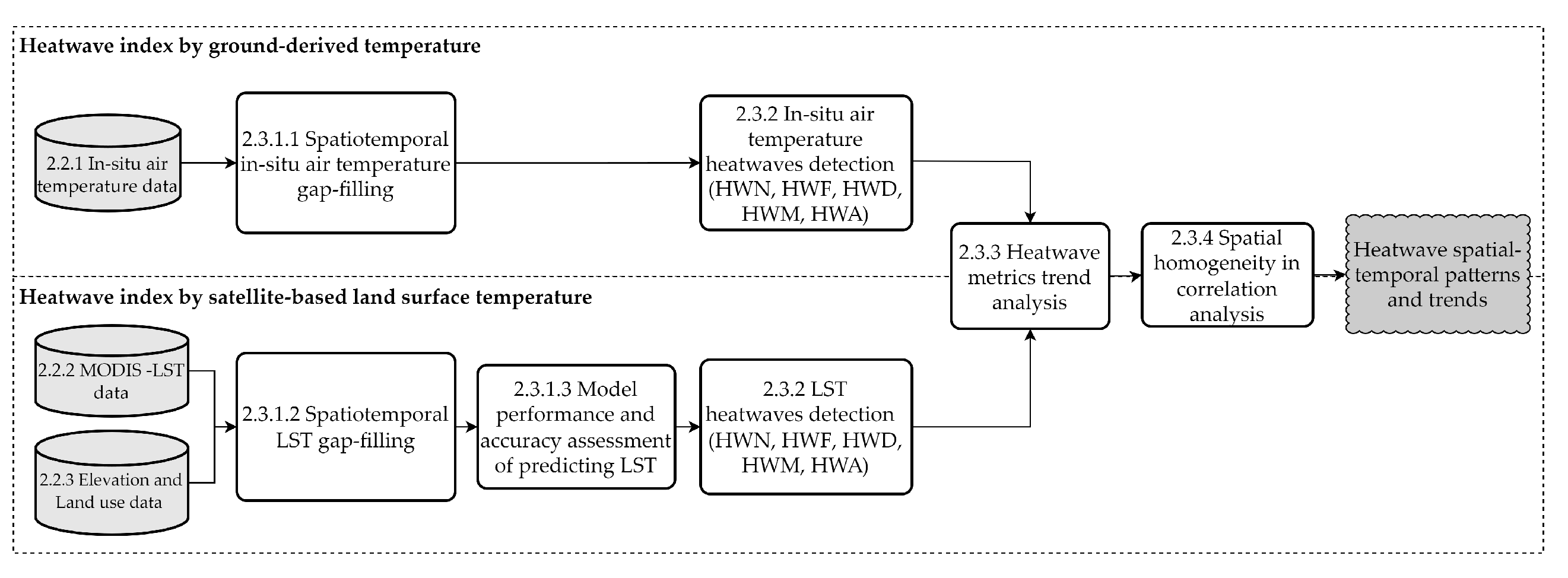
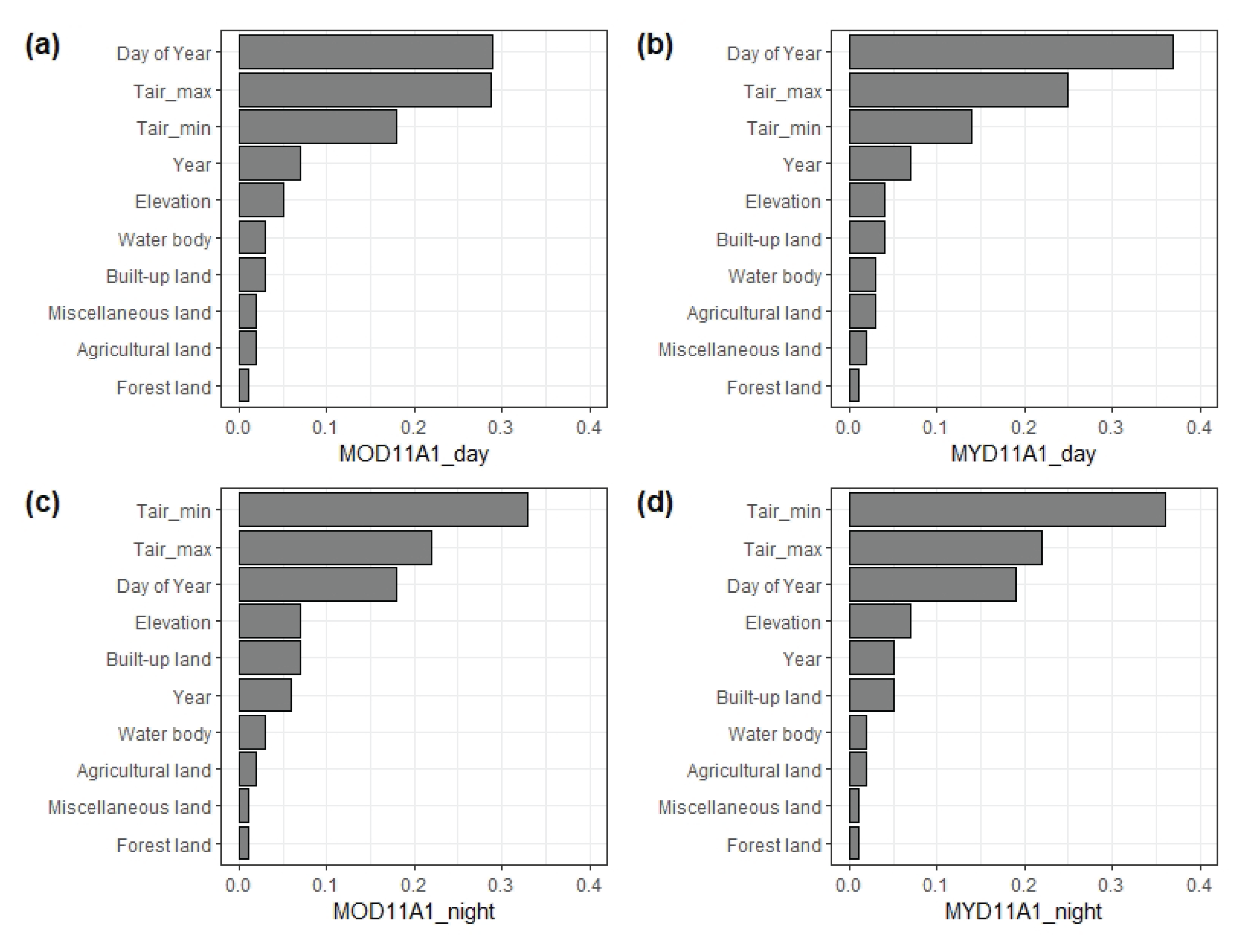
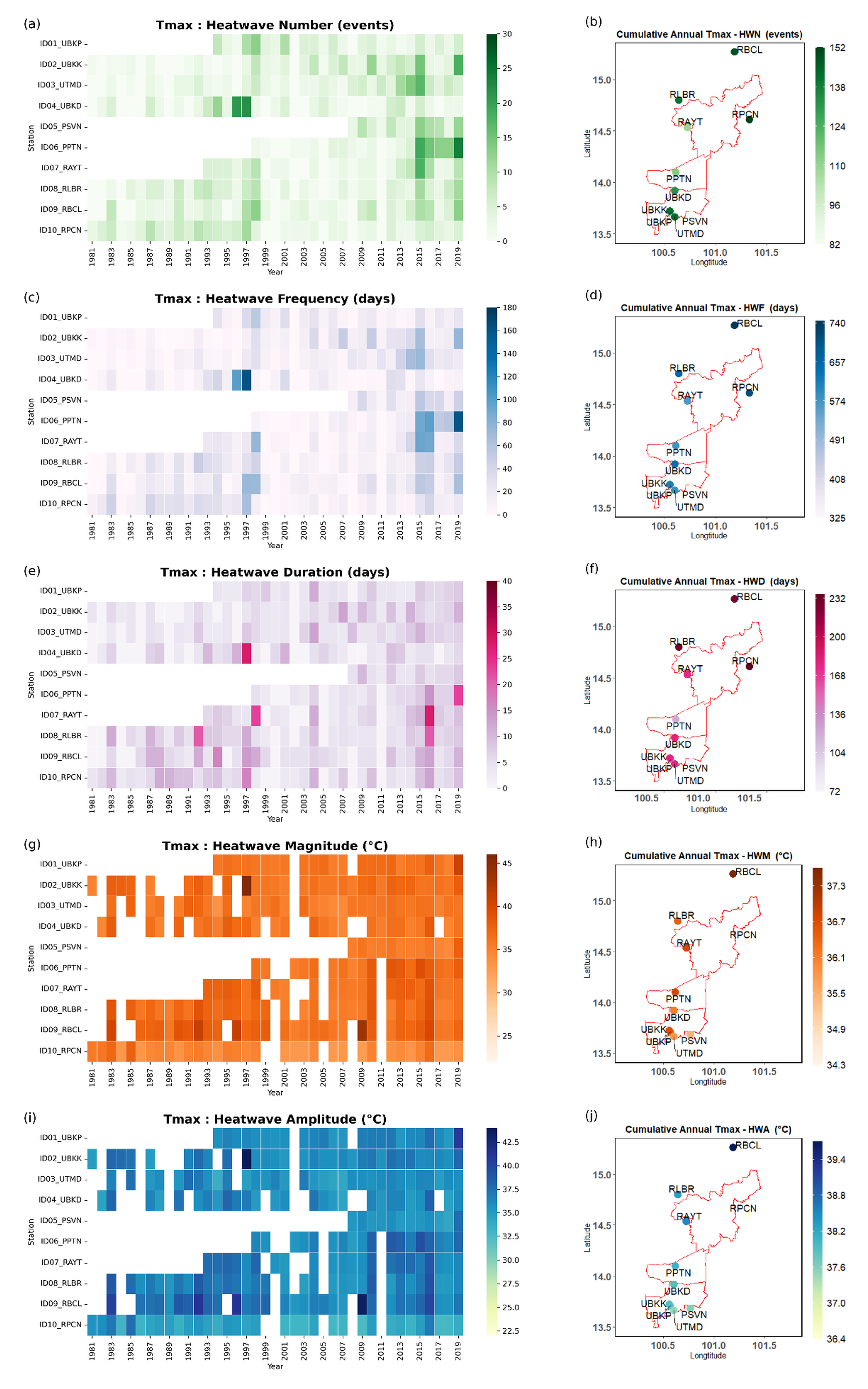
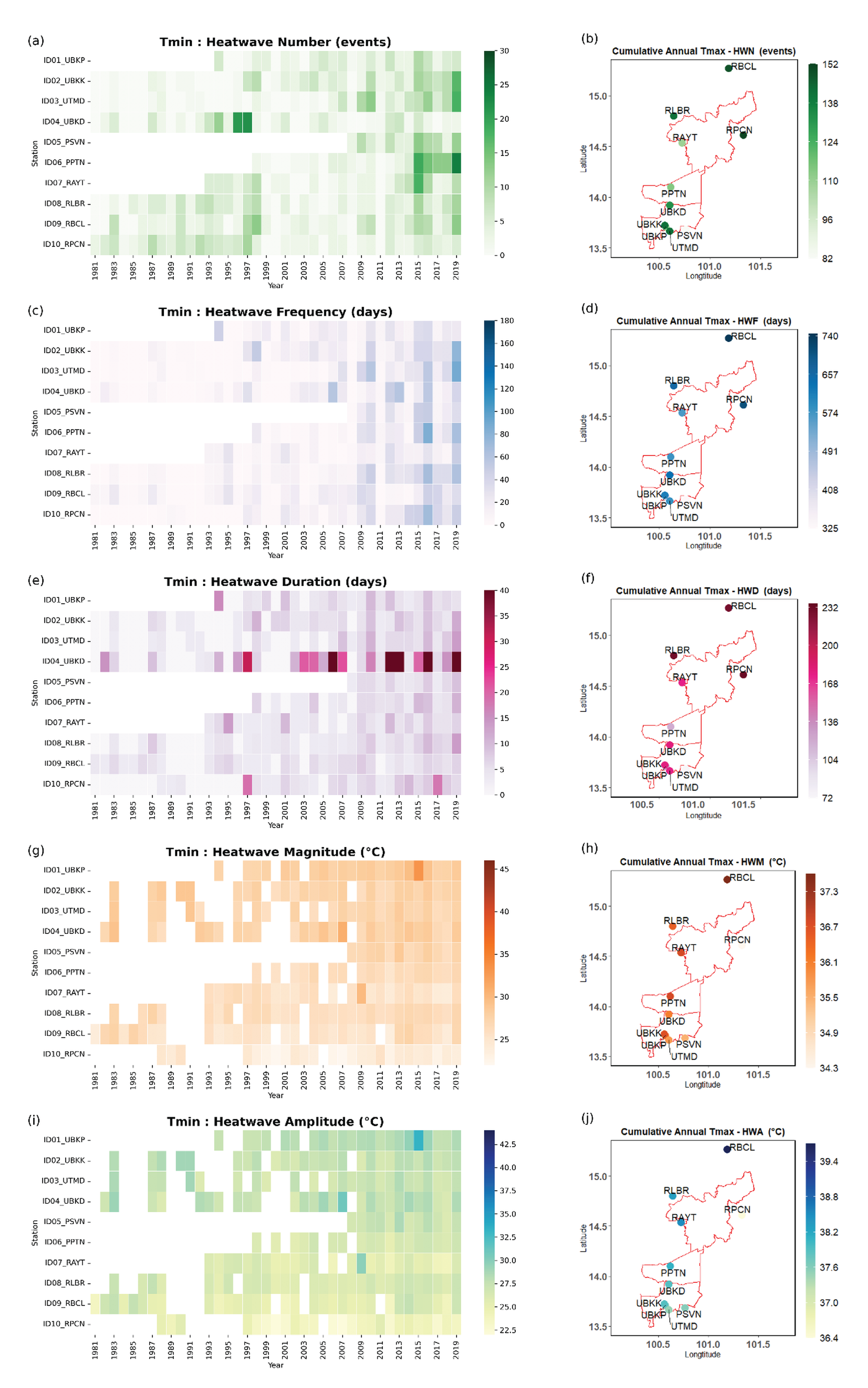
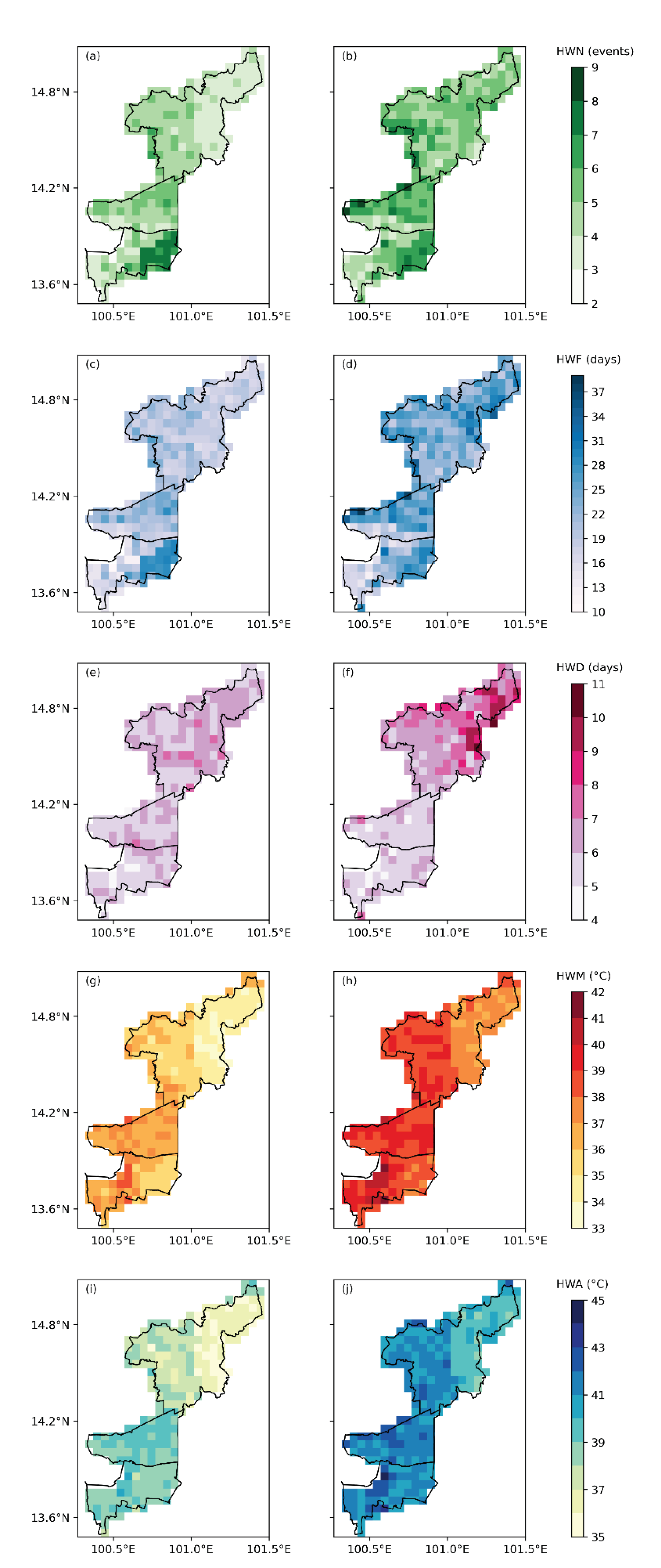
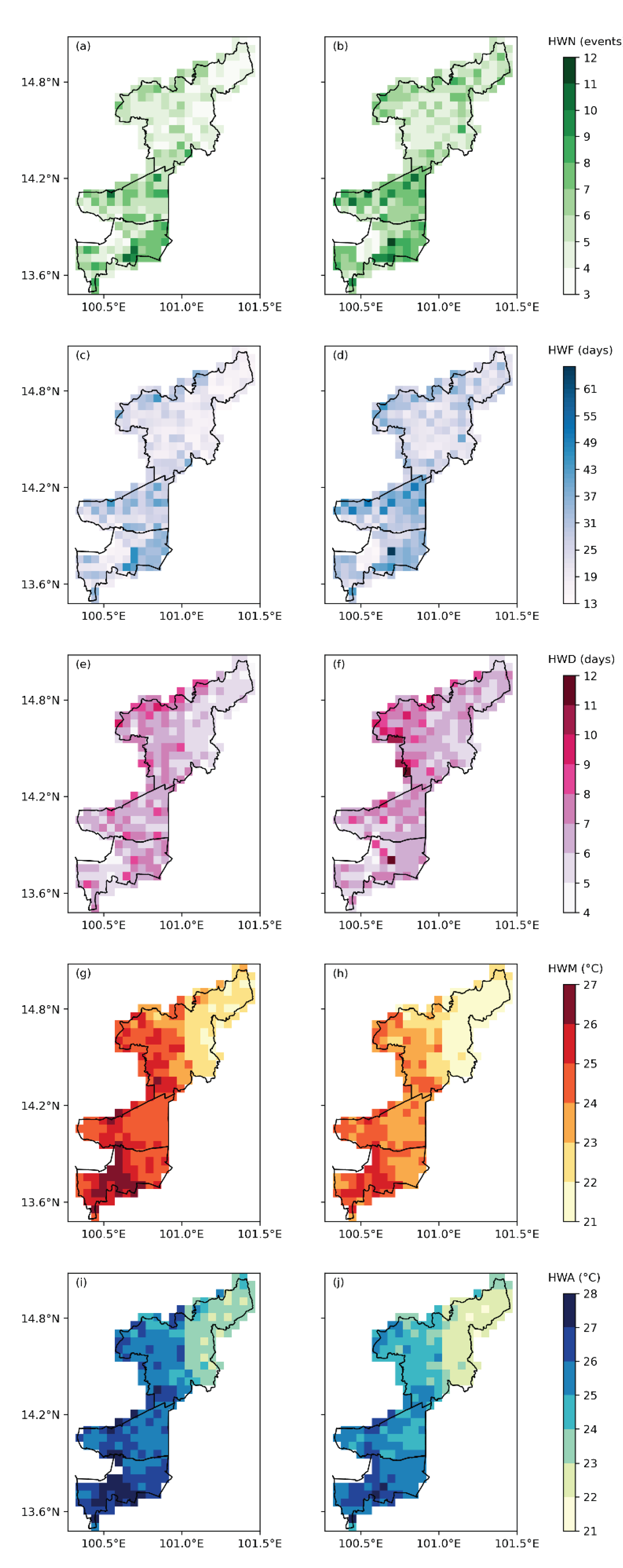
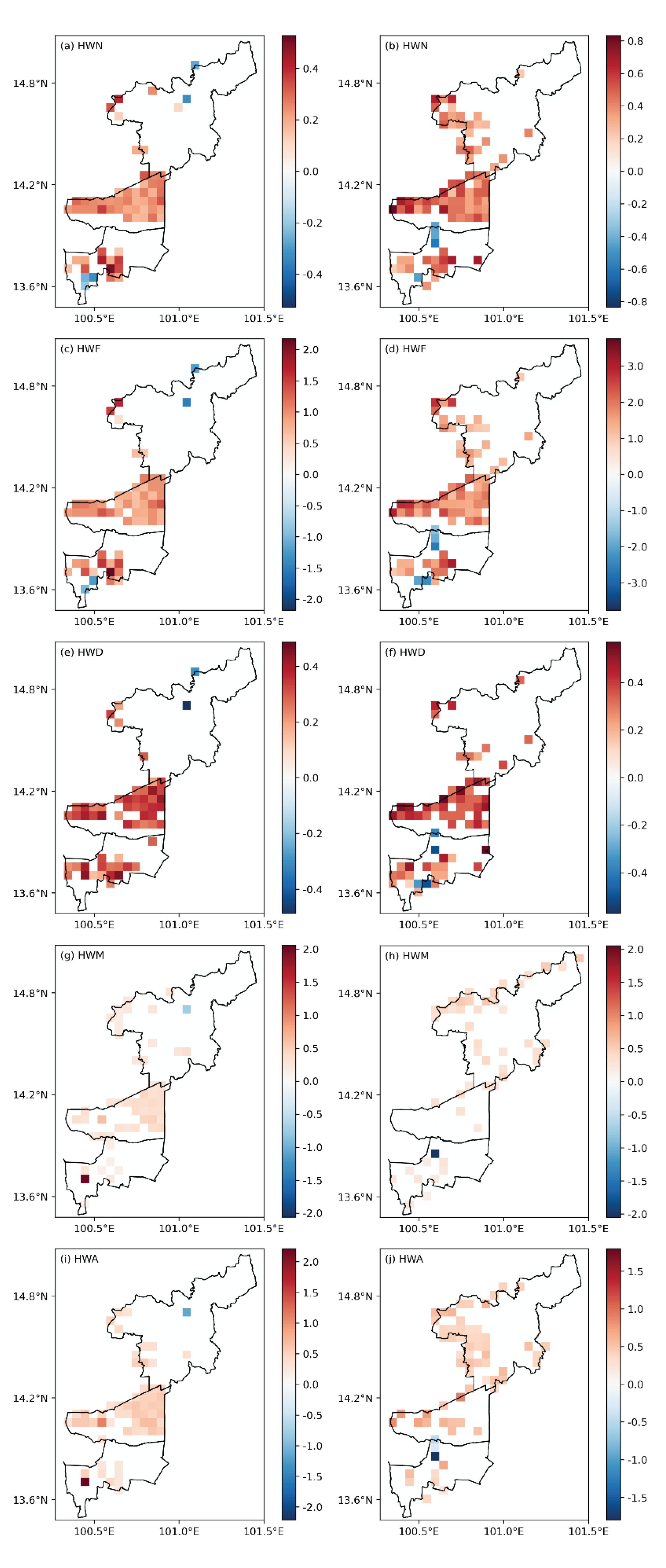
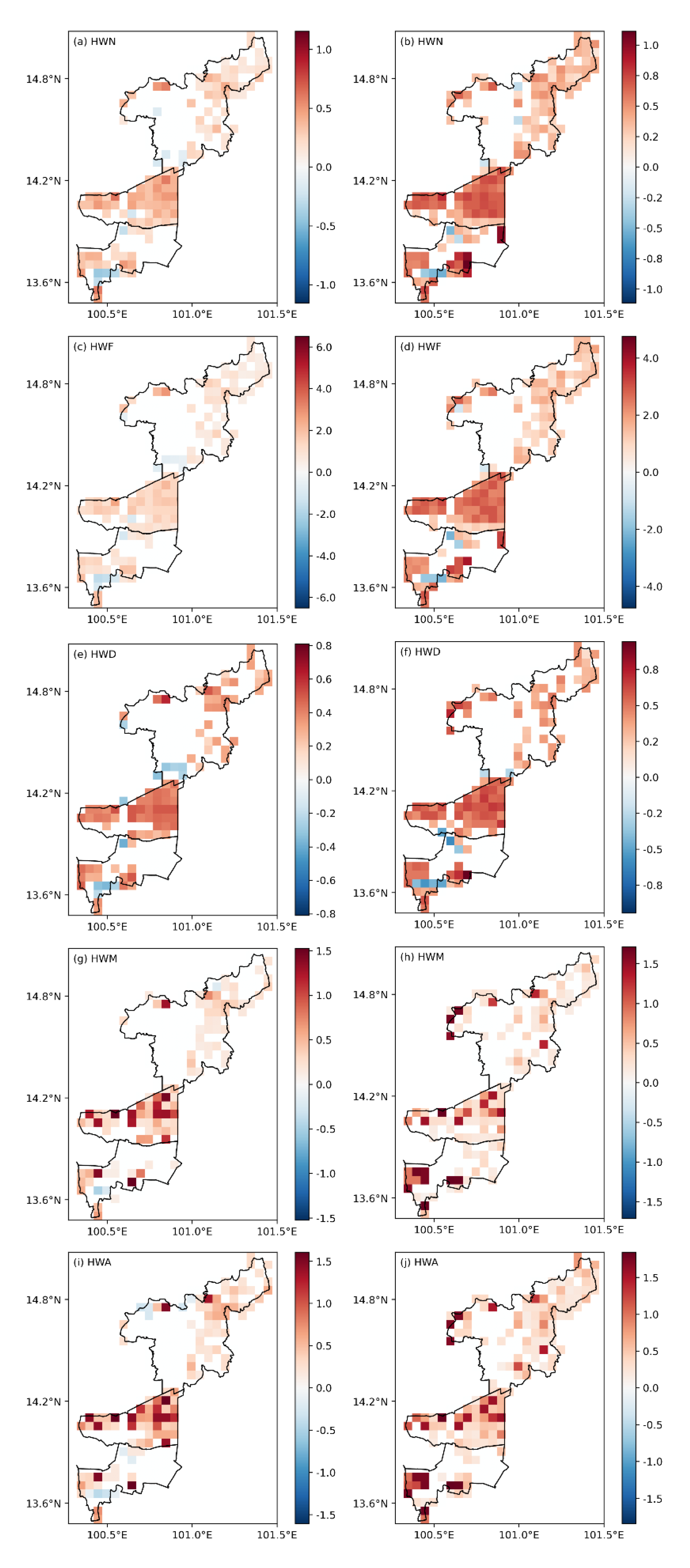
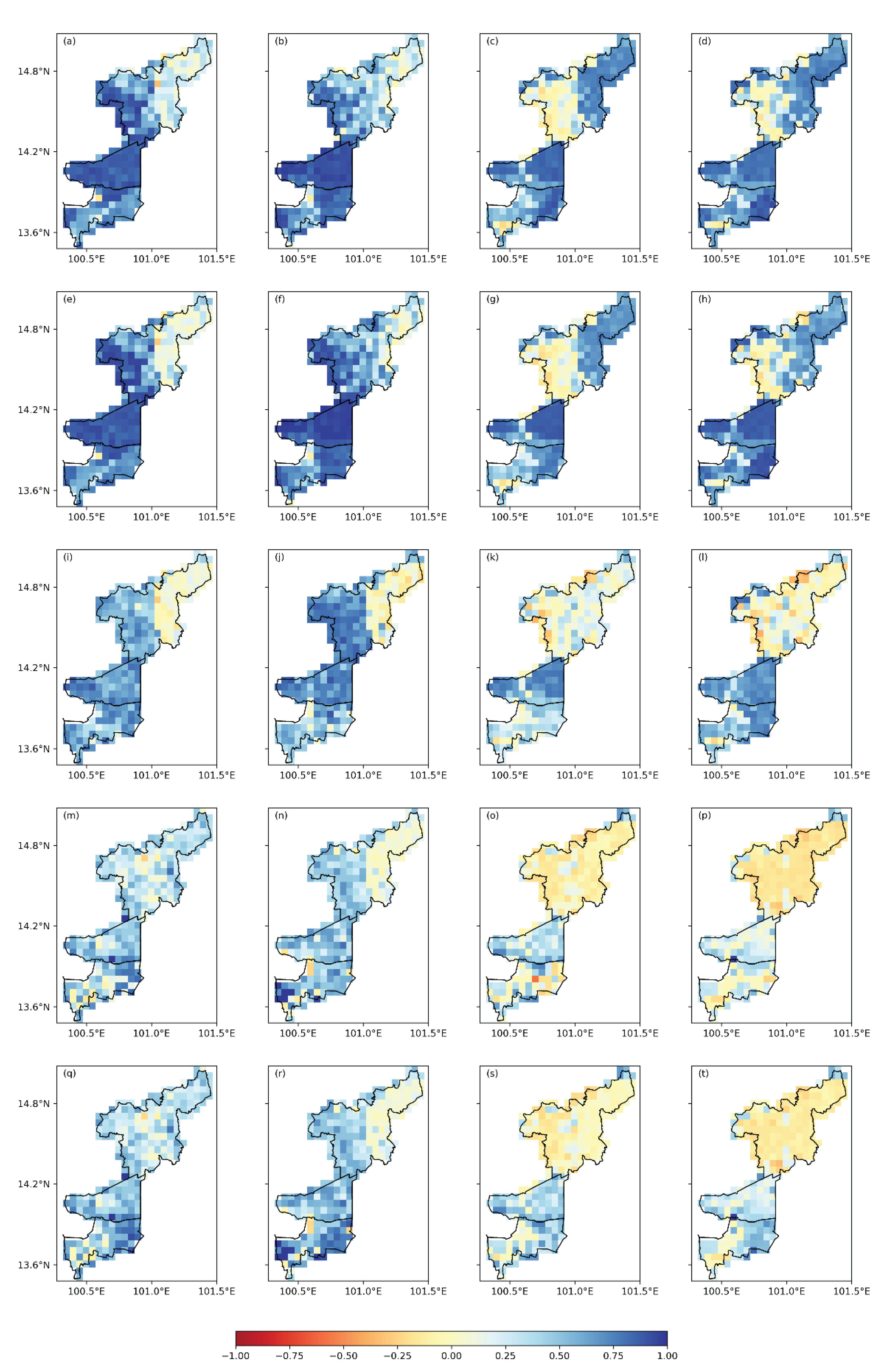
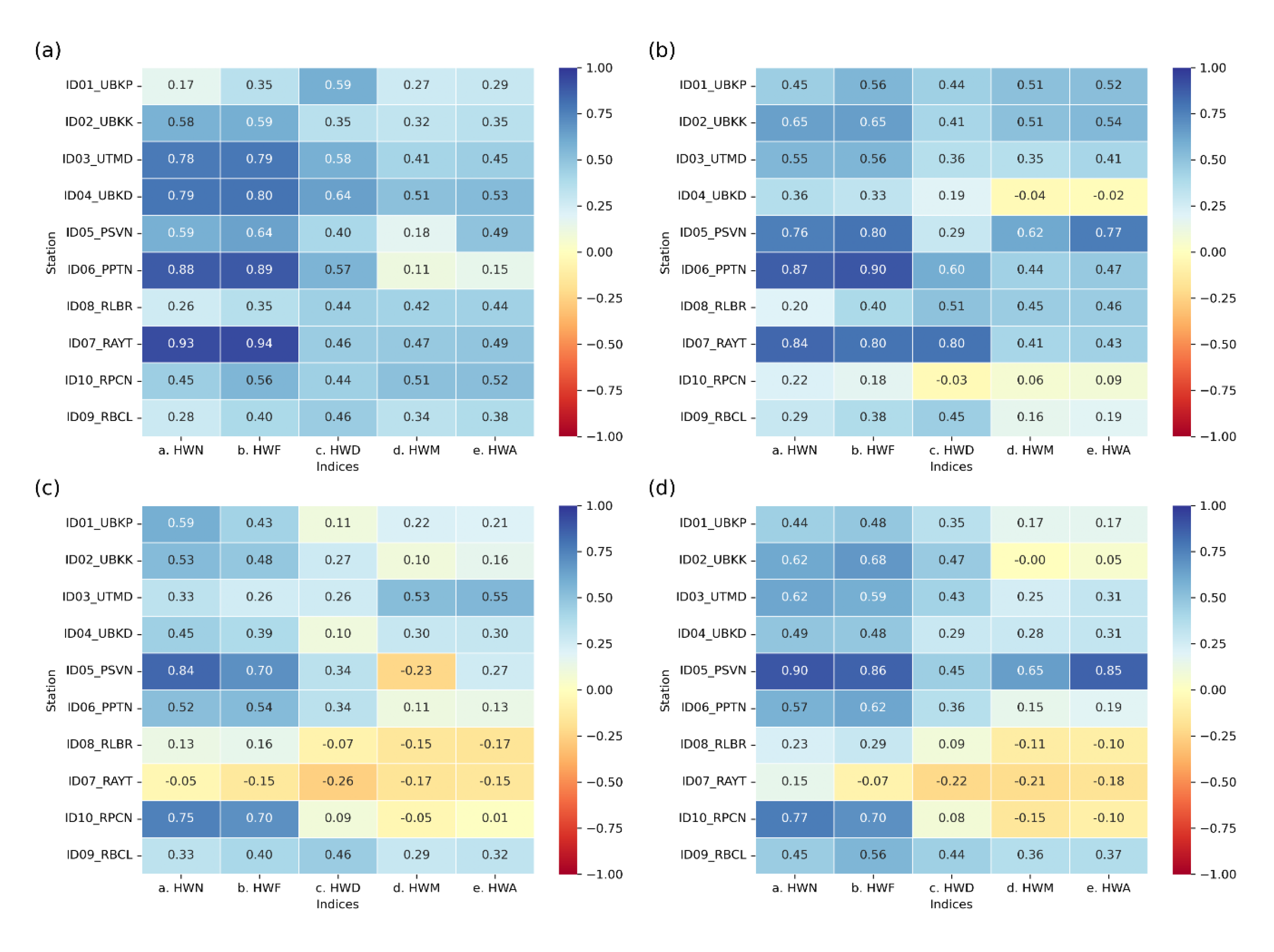
| Station | ID | Station Name | Province | Altitude (m) | Type of Area | Time period (years) |
|---|---|---|---|---|---|---|
| 1 | UBKP | Bangkok Port (Khlong Toei) | Bangkok | 1 | Urban | 1994 – 2019 (26) |
| 2 | UBKK | Bangkok (Queen Sirikit National Convention Center) | Bangkok | 4 | Urban | 1981 – 2019 (39) |
| 3 | UTMD | Thai Meteorological Department (Bang Na) | Bangkok | 3 | Urban | 1981 – 2019 (39) |
| 4 | UBKD | Don Muang Airport | Bangkok | 5 | Urban | 1981 – 2019 (39) |
| 5 | PSVN | Suvarnabhumi Airport | Samut Prakan | 2 | Peri-urban | 2008 – 2019 (12) |
| 6 | PPTN | Pathum Thani Agrometeorological Station | Pathum Thani | 9 | Peri-urban | 1998 – 2019 (21) |
| 7 | RAYT | Ayutthaya Meteorological Station | Ayutthaya | 12 | Rural | 1993 – 2019 (27) |
| 8 | RLBR | Lopburi Meteorological Station | Lopburi | 20 | Rural | 1981 – 2019 (39) |
| 9 | RBCL | Bua Chum Meteorological Station | Lopburi | 54 | Rural | 1981 – 2019 (39) |
| 10 | RPCN | Pak Chong Meteorological Station | Nakhon Ratchasima | 422 | Rural | 1981 – 2019 (39) |
| Index | Abbreviation | Definition | Unit |
|---|---|---|---|
| Heatwave number | HWN | The total number of individual heatwaves detected occurs when temperatures exceed the 90th percentile of or (for ground temperature) and day or night MOD11A1 and MYD11A1 (for LST) for at least three consecutive days. This count starts from the beginning of the period of interest and continues to the end, covering all such events | events |
| Heatwave frequency | HWF | The total number of days that contribute to heatwaves | days |
| Heatwave duration | HWD | The length in days of the longest heatwave | days |
| Heatwave magnitude | HWM | The average of mean daily temperature throughout the duration of heatwave | °C |
| Heatwave amplitude | HWA | The peak daily value in the hottest heatwave (defined as the heatwave with the highest HWM) | °C |
| Statistical Measures | MOD11A1_day (C/V) | MYD11A1_day (C/V) | MOD11A1_night (C/V) | MYD11A1_night (C/V) |
|---|---|---|---|---|
| 0.50/0.45 | 0.51/0.29 | 0.55/0.64 | 0.64/0.48 | |
| RMSE | 2.64/3.79 | 2.79/5.02 | 2.03/2.09 | 1.79/2.57 |
| Min Interval | 2.52/3.79 | 2.66/5.02 | 1.92/2.08 | 1.69/2.57 |
| Max Interval | 2.75/3.79 | 2.92/5.03 | 2.13/2.09 | 1.89/2.51 |
| MAE | 2.02/2.95 | 2.15/3.88 | 1.48/1.61 | 1.33/1.94 |
| MBE | -0.05/-0.41 | -0.08/-0.58 | 0.00/0.05 | 0.19/-0.21 |
| Indices | |||||||||||||||
|---|---|---|---|---|---|---|---|---|---|---|---|---|---|---|---|
| Station | ID | Area type | Time Period (year) | Number of HW Incidence Year (% of occurrence) |
HWN (events) | HWF (days) | HWD (days) | HWM (°C) | HWA (°C) | ||||||
| 1 | UBKP | Urban | 1994 – 2019 (26) | 24(92%) | 22(85%) | 4.2 | 3.5 | 16.7 | 15.5 | 5.0 | 5.2 | 36.3 | 28.4 | 37.7 | 29.3 |
| 2 | UBKK | Urban | 1981 – 2019 (39) | 31(79%) | 27(69%) | 3.6 | 3.5 | 15.8 | 14.5 | 4.6 | 4.1 | 36.7 | 27.5 | 37.9 | 28.8 |
| 3 | UTMD | Urban | 1981 – 2019 (39) | 32(82%) | 24(62%) | 3.7 | 3.0 | 15.0 | 12.3 | 4.5 | 3.3 | 35.8 | 27.2 | 37.5 | 28.5 |
| 4 | UBKD | Urban | 1981 – 2019 (39) | 37(95%) | 27(69%) | 3.4 | 3.4 | 16.4 | 13.5 | 4.6 | 13.5 | 36.1 | 27.7 | 37.9 | 29.0 |
| 5 | PSVN | Peri-urban | 2008 – 2019 (12) | 12(100%) | 12(100%) | 6.8 | 6.8 | 27.1 | 22.5 | 6.0 | 5.4 | 35.5 | 27.1 | 37.6 | 28.8 |
| 6 | PPTN | Peri-urban | 1998 – 2019 (21) | 18(86%) | 18(86%) | 5.2 | 5.2 | 26.4 | 18.8 | 5.5 | 4.6 | 36.8 | 26.3 | 38.1 | 27.8 |
| 7 | RAYT | Rural | 1993 – 2019 (27) | 22(81%) | 22(81%) | 4.0 | 4.0 | 21.0 | 12.9 | 6.5 | 5.0 | 36.8 | 25.6 | 36.8 | 26.4 |
| 8 | RLBR | Rural | 1981 – 2019 (39) | 32(82%) | 32(82%) | 3.6 | 3.6 | 16.9 | 14.3 | 5.9 | 3.8 | 36.5 | 26.3 | 38.3 | 27.4 |
| 9 | RBCL | Rural | 1981 – 2019 (39) | 31(79%) | 31(79%) | 3.8 | 3.8 | 19.1 | 13.1 | 5.9 | 4.0 | 37.6 | 25.5 | 39.7 | 27.0 |
| 10 | RPCN | Rural | 1981 – 2019 (39) | 34(87%) | 34(87%) | 3.9 | 3.9 | 18.2 | 3.6 | 6.0 | 4.1 | 34.3 | 23.7 | 36.4 | 25.6 |
| Station | ID | Dataset | Indices | ||||
|---|---|---|---|---|---|---|---|
| HWN | HWF | HWD | HWM | HWA | |||
| 1 | UBKP | -0.05 | -0.14 | 0.00 | 0.01 | 0.00 | |
| 0.02 | 0.24 | 0.00 | 0.01 | 0.04 | |||
| 2 | UBKK | 0.20 | 0.75 | 0.10 | -0.02 | 0.02 | |
| 0.20 | 0.77 | 0.04 | 0.01 | 0.05 | |||
| 3 | UTMD | 0.20 | 0.75 | 0.10 | -0.02 | 0.02 | |
| 0.25 | 1.00 | 0.08 | 0.01 | 0.07 | |||
| 4 | UBKD | 0.00 | -0.07 | 0.00 | -0.02 | -0.03 | |
| 0.12 | 0.53 | 0.09 | 0.53 | 0.02 | |||
| 5 | PSVN | 0.00 | 0.00 | 0.00 | -0.03 | 0.11 | |
| 0.00 | 0.00 | 0.00 | -0.11 | -0.03 | |||
| 6 | PPTN | 0.45 | 2.00 | 0.27 | 0.05 | 0.17 | |
| 0.14 | 0.00 | 0.55 | 0.02 | 0.14 | |||
| 7 | RAYT | -0.02 | 0.00 | 0.02 | 0.08 | 0.24 | |
| 0.08 | 0.06 | 0.30 | 0.00 | 0.03 | |||
| 8 | RBCL | -0.02 | 0.06 | -0.02 | 0.08 | 0.40 | |
| 0.39 | 1.44 | 0.14 | 0.02 | 0.08 | |||
| 9 | RBCL | -0.05 | 0.04 | -0.03 | 0.00 | 0.25 | |
| 0.06 | 0.00 | 0.27 | 0.00 | 0.02 | |||
| 10 | RPCN | -0.04 | -0.05 | 0.00 | 0.00 | -0.16 | |
| 0.24 | 1.00 | 0.15 | 0.00 | 0.04 | |||
| Heatwave Type | Dataset | Trend | Indices | ||||
|---|---|---|---|---|---|---|---|
| HWN | HWF | HWD | HWM | HWA | |||
| Day | MOD11A1 | Increasing | 22% | 22% | 21% | 20% | 22% |
| Decreasing | 2% | 1% | 1% | 0% | 0% | ||
| MYD11A1 | Increasing | 30% | 27% | 23% | 18% | 23% | |
| Decreasing | 1% | 2% | 1% | 0% | 1% | ||
| Night | MOD11A1 | Increasing | 44% | 43% | 34% | 38% | 40% |
| Decreasing | 4% | 4% | 4% | 1% | 4% | ||
| MYD11A1 | Increasing | 56% | 52% | 41% | 47% | 57% | |
| Decreasing | 3% | 3% | 3% | 0% | 0% | ||
| Data | Pearson’s correlation coefficient (r) | ||||
|---|---|---|---|---|---|
| HWN | HWF | HWD | HWM | HWA | |
| vs. MOD11A1 (day) | 0.55 | 0.66 | 0.48 | 0.32 | 0.35 |
| vs. MYD11A1 (day) | 0.62 | 0.71 | 0.48 | 0.39 | 0.40 |
| vs. MOD11A1 (night) | 0.31 | 0.26 | 0.10 | 0.02 | 0.07 |
| vs. MYD11A1 (night) | 0.36 | 0.45 | 0.26 | 0.08 | 0.13 |
Disclaimer/Publisher’s Note: The statements, opinions and data contained in all publications are solely those of the individual author(s) and contributor(s) and not of MDPI and/or the editor(s). MDPI and/or the editor(s) disclaim responsibility for any injury to people or property resulting from any ideas, methods, instructions or products referred to in the content. |
© 2024 by the authors. Licensee MDPI, Basel, Switzerland. This article is an open access article distributed under the terms and conditions of the Creative Commons Attribution (CC BY) license (http://creativecommons.org/licenses/by/4.0/).





